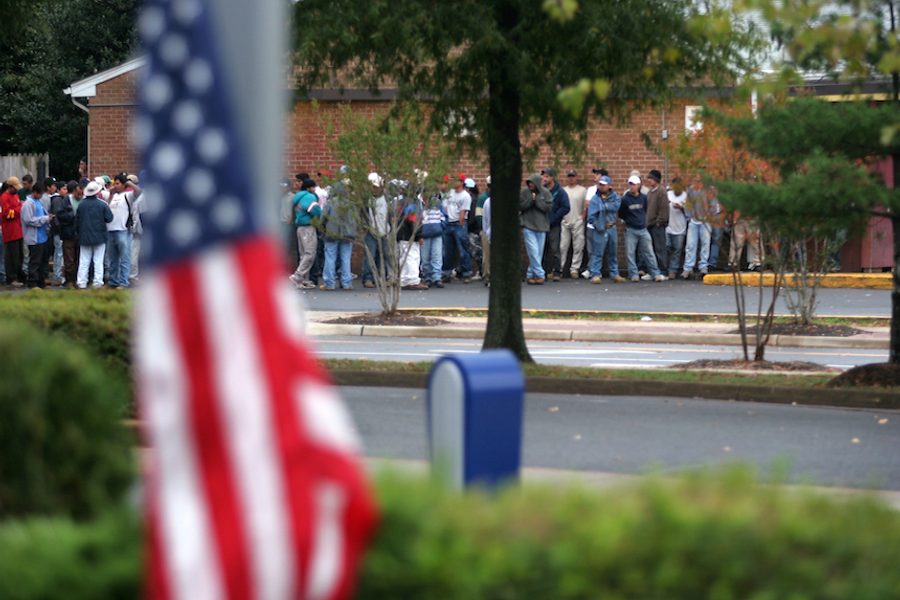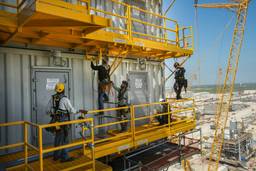
CHICAGO — Come sunrise, the men fill the street corner, among them Luis, quietly sitting by himself, nurturing hopes for work today.
There was no work yesterday, nothing the day before and nothing for weeks.
Still, the 50-year-old Guatemalan, who didn’t want his last name used, waits in the growing heat, saying he has no other choice.
He waits even though he hates day labor work, because he says it is sometimes dangerous, barely enough to live on, and some of the men on the street corner have bullied and hurt him on the job.
The factory where he worked for almost a decade shut down a few years ago, he can’t find any work as a caregiver, and, he says, the factories aren’t hiring or they are shutting down.
He says he has papers to show he is a legal resident in the United States, but he suspects that many of the men standing around him don’t have that status.
That’s not the case for Carlos Sanchez, 70, and Gustavo Almaraz, 28, who are standing nearby. Carlos says he is Puerto Rican and Gustavo says he was born in the United States.
But they say that many workers lack papers and so they suffer. Often, the contractors who hire the men off the street corner “automatically think you don’t have papers,” explains Almaraz. And that’s a problem, because they want to take advantage of you. “Some of the people here (doing the hiring) are mean,” he adds.
The two also say they know how to take care of themselves.
Sanchez says he knows how to do a lot of jobs and how to deal with people, starting out decades ago as a migrant worker earning 35 cents an hour. And Almaraz says he has picked up enough skills that he can virtually take every job offered on the street corner.
“It’s all on you,” Almaraz explains. “You see a car coming in and you have to go up and say, ‘Hey boss, what do you need?’”
The secret is finding a good boss and somebody who needs you for a long time, he says. It also involves knowing, he says, when to walk away from someone who abuses you. “I had a good-paying job with an electrician, but he started to become disrespectful. He started to yell and insult me.”
Almaraz says he won’t work for less than $15 an hour, but surveys indicate laborers often earn minimum wages or less, and sometimes nothing. “Nobody can live on less than $100 a day,” Almaraz says.
Near them is a 65-year-old Mexican: a short, stocky, balding man, who says he has been doing day labor ever since coming to the United States without papers 12 years ago.
He hasn’t been able to find work and so he says he will take less than the others. “Sometimes they don’t pay. It’s very difficult. There is no work and everything is expensive,” he says in Spanish.
Time passes, and the men disappear from the street corner. Some are off to work, getting into the trucks and vans that pick them up.
As soon as someone pulls up onto the gasoline station’s street corner, the men rush them, huddling by the vehicle’s windows, bargaining furiously as they tout their skills. And some just wander off.
Not Luis. He sits waiting. Some jobs he won’t take. “I have friends who were injured doing roofing, and they went home (to Guatemala) handicapped,” he says.
Not too long ago, he took a moving job with another worker. It was supposed to be an easy three-hour job. But the items they moved were so heavy, he sat at home for three days afterward, his hands shaking.
“A lot of people will do this work. They don’t speak the language so they have to. But I don’t have to,” he says.
He waits along with more than 100,000 others who gather daily on dozens of street corners across the United States, according to figures from 2006. It is a world, where workers are often cheated out of their wages, injured on the job and then left without medical care, according to a 2006 survey. Where workers who complain often suffer retaliation by employers who fire them, suspend them, or threaten to call immigration officials.
As the hours pass, Luis huddles in the scorching sunlight, watching out for anybody looking for a worker and a job he can do.
Most of the men are gone, but not him.
A former labor writer for the Chicago Tribune, Stephen Franklin is a Pulitzer Prize finalist and an adjunct professor at the University of Illinois Urbana-Champaign School of Labor and Employment Relations.







